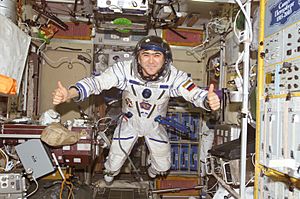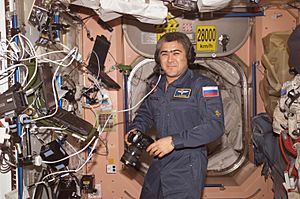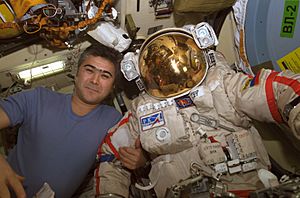Salizhan Sharipov facts for kids
Quick facts for kids
Salizhan Shakirovich Sharipov
|
|
|---|---|
 |
|
| Born | 24 August 1964 |
| Status | Retired |
| Nationality | Uzbek Russian |
| Occupation | Air Force Pilot |
| Awards | Hero of the Russian Federation |
| Space career | |
| Roscosmos cosmonaut | |
| Rank | Colonel |
|
Time in space
|
201d 14h 50m |
| Selection | 1990 Cosmonaut Group |
| Missions | STS-89, Soyuz TMA-5 (Expedition 10) |
|
Mission insignia
|
|
Salizhan Shakirovich Sharipov, born on August 24, 1964, is a retired Kyrgyz cosmonaut of Uzbek background. A cosmonaut is a space traveler, similar to an astronaut. Sharipov helped with a project called "Advanced Diagnostic Ultrasound in Microgravity," which studied how ultrasound works in space. He flew to space twice: once in 1998 with the U.S. and again in 2004 with Russia. During his missions, he completed two spacewalks. Sharipov retired from his cosmonaut career on July 18, 2008.
Contents
About Salizhan Sharipov
Sharipov was the first cosmonaut from the country of Uzbekistan. His family background includes both Uzbek and Tajik heritage. He is married to Nadezhda Mavlyanovna Sharipova. They have a daughter named Nigara, born in 1988, and a son named Zhakhongir, born in 1992. Salizhan Sharipov enjoys playing football and reading books. His father, Shakirzhan Sharipov, lives in Uzgen.
His Education and Training
Salizhan Sharipov finished the Soviet Air Force Pilot School in 1987. This is where he learned to fly military aircraft. Later, in 1994, he earned a degree in cartography from Moscow State University. Cartography is the science of making maps.
Awards and Special Honors
Sharipov has received many important awards for his work. In 1988, he was named a Pilot-Cosmonaut of the Russian Federation. In 1998, he became a Hero of the Kyrgyz Republic, which is a very high honor. He also received the Gold Star Medal of the Hero of the Kyrgyz Republic, also known as the Ak Shumkar Medal, in 1998. He was given medals from the Russian Federation Air Force and a NASA Space Flight Medal in 1998. To celebrate his achievements, the Kyrgyz Republic issued a special postal stamp with his picture on April 20, 2005.
Flying Experience
After graduating from pilot school in 1987, Sharipov became a pilot-instructor. He taught eight new pilots, called cadets, how to fly. He has spent over 950 hours flying different types of aircraft. He has experience flying planes like the MiG-21 and the L-39.
Becoming a Cosmonaut
In 1990, Salizhan Sharipov was chosen by the Gagarin Cosmonaut Training Center (GCTC) to become a cosmonaut-candidate. He completed his basic space training in 1992. On March 11, 1992, he officially became a test cosmonaut. He trained to be a crew commander for missions to the Mir space station. From August 1997 to January 1998, he trained at the Johnson Space Center in the U.S. for the STS-89 mission.
Space Shuttle Mission: STS-89
Sharipov was a mission specialist on the STS-89 crew. This mission took place from January 22 to 31, 1998. It was the eighth time a U.S. Space Shuttle docked with the Russian Mir space station. During this mission, the crew moved over 8,000 pounds of science equipment, supplies, and water from the Space Shuttle Endeavour to Mir. STS-89 also brought U.S. astronaut Andy Thomas to Mir and brought David Wolf back to Earth. The mission lasted 8 days, 19 hours, and 47 seconds. The shuttle traveled 3.6 million miles and orbited the Earth 138 times.
Life on the International Space Station: Expedition 10
Sharipov also served as a flight engineer for Expedition 10 to the International Space Station (ISS). The Soyuz TMA-5 spacecraft, carrying Sharipov, cosmonaut Yuri Shargin, and NASA astronaut Leroy Chiao, launched from the Baikonour cosmodrome on October 14, 2004. After two days of flying, the Soyuz spacecraft docked with the ISS on October 16. Sharipov joined the Expedition 10 crew as a flight engineer. Their main job was to keep the ISS working well.
While on the ISS, Sharipov did several science experiments for the Russian Space Program. One experiment, called SRS, studied how to create new materials using low temperatures in space. He also did biotechnology experiments using stem cells, hoping to help develop treatments for diseases. He also helped with studies about Earth's environment from space.
After spending 192 days in space, Sharipov returned to Earth on April 24, 2005. He landed with Leroy Chiao and ESA astronaut Roberto Vittori aboard the Soyuz TMA-5 spacecraft. The Soyuz capsule landed about 90 kilometers north of the town of Arkalyk.
Spacewalks in Orbit
Salizhan Sharipov has completed two spacewalks during his career. In total, he spent 10 hours and 34 minutes working outside the International Space Station.
His first spacewalk was on January 26, 2005. He and NASA astronaut Leroy Chiao left the ISS from the Pirs airlock. They wore Russian Orlan spacesuits, which have red stripes. The two spacewalkers worked quickly to install a new work platform and test a robot outside the Zvezda module. Sharipov and Chiao also moved a Japanese experiment and connected an antenna for the robot. They also looked at vents used by the station's oxygen generator. The spacewalk lasted 5 hours and 28 minutes.
Sharipov's second spacewalk happened on March 28, 2005. Again, he and Leroy Chiao wore Russian Orlan suits and used the Pirs airlock. They installed the last three antennas on the Zvezda Service Module. These antennas were for the ATV, a spacecraft that brings supplies. They also installed a GPS antenna for the ATV. During this spacewalk, Sharipov and Chiao launched a small Russian experiment called Nanosatellite. Sharipov pushed the tiny satellite away from the ISS. This small satellite was about a foot long and weighed 11 pounds. It had a transmitter inside. The goal of this experiment was to learn how to control small satellites and develop new sensors. This spacewalk lasted 4 hours and 30 minutes.
See also
 In Spanish: Salijan Sharipov para niños
In Spanish: Salijan Sharipov para niños
- List of Heroes of the Russian Federation




